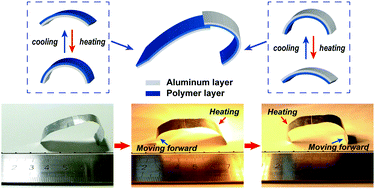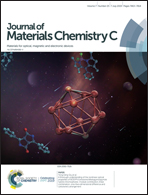Thermo-responsive aluminum-based polymer composite films with controllable deformation†
Abstract
Herein, a series of novel thermo-responsive polymer/aluminum bilayer composite films were conveniently prepared by solution casting. These films show rapid and reversible deformation in response to changes in temperature due to the large difference between the thermal expansion properties of the two layers. All the films exhibit good mechanical properties. The effects of layer thickness, polymer composition and structure on the thermo-responsive deformation were comprehensively investigated. The optimum deformation temperature (Td) is mainly determined by the glass transition temperature (Tg) of the polymer layer. Therefore, the Td can be easily adjusted by varying the compositions and structures of the copolymers to meet the requirements of applications. In addition, the increased crystallinity of the copolymers can accelerate their deformation. It is very facile to control the deformation direction by the prestress applied to the film. Combined with the good electrical conductivity of aluminum, these films can be used as thermo-responsive conductive materials. In this study, due to the good properties, such as rapid and reversible thermo-responsive deformation, excellent mechanical properties and controlled deformation, of these composite films, some complex deformations and soft robotics, such as lotus, creeper and gripper, can be well designed to mimic the movements in nature.



 Please wait while we load your content...
Please wait while we load your content...